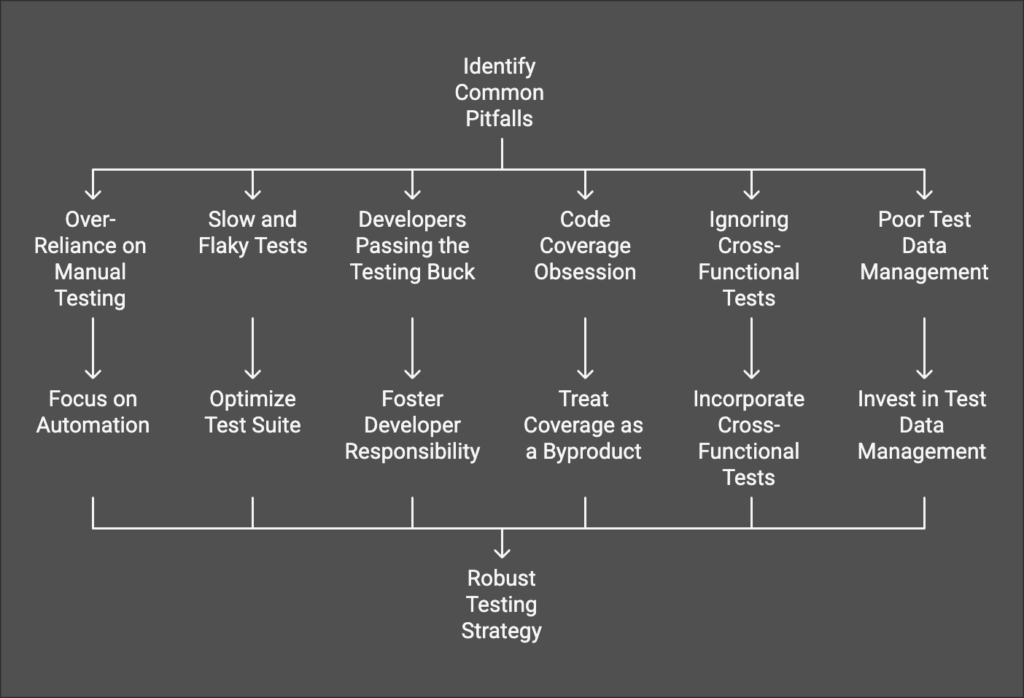Building a Rock-Solid Test Strategy: Pitfalls to Dodge

In today’s fast-paced development environment, the pressure to ship features quickly and reliably can sometimes overshadow the importance of a strong testing strategy. However, without a robust approach to testing, your team might find themselves in a swamp of bugs, missed deadlines, and dwindling stakeholder confidence. Here are some of the most common pitfalls teams encounter and practical ways to sidestep them.
The Trap of Over-Reliance on Manual Testing
Manual testing has its place, especially for exploratory purposes, but leaning too heavily on it can quickly become a bottleneck. It’s slow, error-prone, and not repeatable—an issue that grows as systems become more complex.
How to fix it:
Focus on automation for repetitive and regression tests. Automating these tests provides immediate value, freeing up manual testers to focus on edge cases and creative testing scenarios that machines can’t handle.
Slow and Flaky Tests? Say Goodbye to Developer Confidence
A slow or flaky test suite is a confidence killer. Developers waste hours waiting for tests to complete or rerunning tests that mysteriously fail without any code changes. This often leads to tests being ignored, defeating their purpose altogether.
How to fix it:
Optimize your test suite for speed and reliability:
- Use the lowest level of testing (unit, integration, functional) that gets the job done.
- Prioritize fixing flaky tests over other tasks.
- Regularly review and refactor your tests to remove unnecessary dependencies.
Developers Passing the Testing Buck
Testing isn’t just the QA team’s responsibility. When developers don’t own their share of the testing burden, the QA team often ends up as a bottleneck, leading to delayed feedback loops and an over-reliance on higher-level tests.
How to fix it:
Foster a culture where developers are responsible for writing unit, integration, and contract tests. Make testing an integral part of your definition of done for every user story, and encourage pairing between developers and QAs for more complex testing scenarios.
The Code Coverage Obsession
Code coverage is a helpful guideline, but chasing 100% coverage can lead to meaningless tests. Tests written solely to satisfy coverage goals often lack assertions, focusing more on inflating numbers than improving code quality.
How to fix it:
Treat code coverage as a byproduct, not a target. Instead, focus on writing meaningful tests that improve the reliability and maintainability of your system. Educate developers on effective testing practices, and consider bringing in experts or coaches if needed.
Ignoring Cross-Functional Tests
Performance, security, accessibility, and compliance—these cross-functional aspects often take a backseat in favor of functional testing. Neglecting them can lead to costly failures in production, especially in regulated industries.
How to fix it:
Incorporate cross-functional tests into your strategy from day one. Automate these tests wherever possible and make them part of your CI/CD pipeline. This ensures issues are caught early, not after your system goes live.
Poor Test Data Management
Struggling with test data can make writing new tests a tedious process. Worse, pulling production data into test environments without proper anonymization can create compliance nightmares.
How to fix it:
Invest in automated test data generation and management from the start. Ensure your team has easy access to create and modify test data. If you need insights from production data, anonymize it thoroughly before using it in tests.
Wrapping It Up
A solid test strategy isn’t a one-time effort—it’s an ongoing commitment to quality and efficiency. By avoiding these pitfalls, you can build a testing ecosystem that supports rapid development without sacrificing reliability. Take time to revisit your test strategy with your team and ensure it’s setting you up for long-term success.
Subscribe to the Next Iteration Newsletter to get members only content and insights directly in your inbox!
